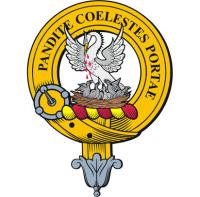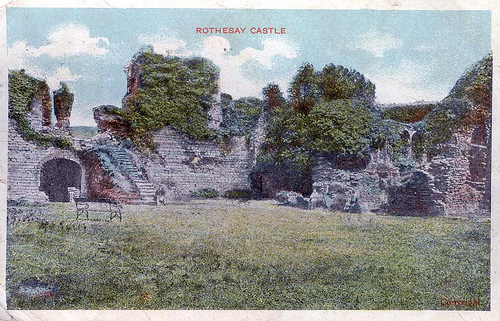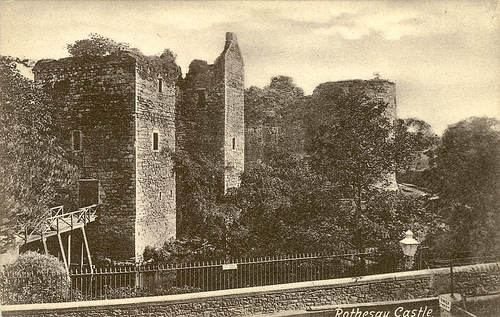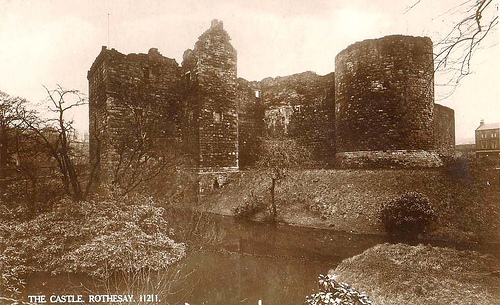
Rothesay Castle stands in a prominent position in the centre of the town of Rothesay on the Isle of Bute. In Scottish terms it is an unusual castle, being largely circular. It is also remarkably well ...Rothesay Castle stands in a prominent position in the centre of the town of Rothesay on the Isle of Bute. In Scottish terms it is an unusual castle, being largely circular. It is also remarkably well preserved for such an early castle, with much of what you see today dating directly back to its original construction in the early 1200s.
In about 1200, Bute was granted by William I to his hereditary Steward, Alan. The island had within living memory formed part of a Norse empire that included Kintyre, the Isle of Man and the Western Isles, and it continued to be a disputed territory over which William I wished to strengthen his grip.
Bute's best natural harbour is formed by the north-facing Rothesay Bay on the island's east coast, and Alan moved swiftly to build a fortification on low lying ground at the head of the bay. This first castle was probably of wood, but by 1230 his son, Walter II, Steward of Scotland, had replaced it with a circular stone castle, probably surrounded by a moat, the inner edge of which would have been defended by a wooden wall.
In 1230 King Håkon IV of Norway sent a fleet under the command of Uspak, the King of Man, to retake the Isle of Bute. The siege of Rothesay Castle lasted three days, and according to a contemporary account was a vicious affair in which Nowegian attackers hacked their way through the stone wall with their axes while, amongst other things, boiling pitch was poured on them from above.
Their breach of the wall proved conclusive and the Norwegians eventually took the castle. But no sooner had they done so than a large Scottish fleet was sighted and the Norwegians had to withdraw to Kintyre, where King Uspak died of injuries suffered in the siege.
Entrance Passage
The Hall in the Gatehouse
Castle Model in the Gatehouse
Spiral Staircase in the Gatehouse
Chapel Interior
Rothesay Castle was again taken by the Norse, this time under the personal command of Håkon IV, in 1263. The castle surrendered in return for a guarantee of safe passage for the defenders, though a number were subsequently killed. Again, however, the Norse hold on Bute was brief. After defeat by Alexander III (and the weather) at the Battle of Largs in September 1263, Håkon IV and his fleet retired to Kirkwall on Orkney, where he died. With him died any realistic prospects of a Norwegian resurgence in the Western Isles and three years later remaining Norwegian claims were surrendered to (or brought out by) the Scottish Crown under the terms of the Treaty of Perth.
The Norwegian attacks had shown that Rothesay Castle was not the impregnable fortress its builders had hoped, and in the last decades of the 1200s it was significantly strengthened with the addition of four circular towers projecting from the walls and a gatehouse on the northern side of the castle.
In 1371 Robert II succeeded to the Scottish Crown, and with him the Hereditary High Stewards of Scotland became the Kings of Scotland: commencing the three hundred year reign of the House of Stewart. Robert II spent much of his time at Rothesay Castle, as did his son, Robert III, who died there on 4 April 1406.
The castle next played an important role in Scottish history under James IV, who in the 1490s sought to regain effective control of the Western Isles from John, Lord of the Isles. James IV, and, after his untimely and unnecessary death at Flodden, James V, oversaw significant works at Rothesay Castle.
These included the expansion of the gatehouse to add space for a great hall and two further floors of accommodation; the increase in height of the two northern towers and the walls linking them to the gatehouse; and, probably, the construction of the chapel, the only building to survive in any recognisable form within the castle walls.
In the 1650s the castle was used as a base by Cromwellian troops and it is possible they tried to render its defences useless when they left in 1659. The castle was attacked during a failed revolt against James VII/II by the Duke of Argyll in May 1685 (see our Historical Timeline) and further damaged.
In 1816 the 2nd Marquess of Bute employed 70 men to excavate the ruins of the castle, and from 1872 to 1879 the 3rd Marquess of Bute undertook a more extensive program of consolidation, during which the moat was re-excavated. In 1900 the gatehouse was reconstructed and the great hall was made usable again: the reconstruction being done in a reddish stone to distinguish it clearly from what already existed.
In 1937 part of the north west tower, converted to a dovecote in the 1600s, collapsed and was rebuilt. In 1961 Rothesay Castle was placed in State care and it is now looked after by Historic Scotland
See 2 more posts from Tartan
Rothesay Castle Isle Of Bute Pre 1914
page=1&callback_module_id=pages&callback_item_id=120&year=&month=
View More











